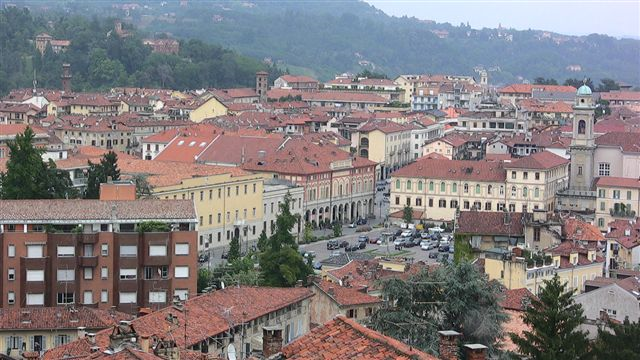The Magic of Biella: Why Italian Fabric Mills Love this Village
There are only a few things for certain in this world; death, taxes, and Italian fabric mills based in Biella.
If you look up the origin of your favorite mill, Vitale Barberis, Loro Piana, Zegna, Guabello, chances are their mills are in this small, northern Italian town 50 miles east of Milan called Biella. This town of only 46,000 is nestled at the foot of the Italian Alps and has small Alpine rivers and lakes surrounding it. These Alpine rivers carry the soft water that washes the wool. This soft water is what Biella is known for and has made it the headquarters for processing wool for over 1000 years.
Piazzo Biella, Biella, Italy.
So why have Italians made their fabric in Biella and what makes it so special?
Originally, Biella possessed unique geographical features that brought settlers there; namely, high mountain pastures with temperatures moderated by the Italian Alps. This brought the sheep farmers to the area for grazing, and they also took advantage of the many Alpine streams and lakes. The excess of sheep naturally brought the woolen industry to Biella; it was very common for families to have looms in their homes, passing the trade down from generation to generation.
One of the many soft-water Alpine rivers that flow around the city.
Slowly, over hundreds of years, Biella’s reputation for fine fabrics grew throughout Italy and Europe. But the world changed at the end of the 1700s. The Industrial Revolution turned industries upside down, particularly the fabric industries.
By the early 1800s, mills in France, Germany & England began implementing mechanical looms that could outpace hand-looms in terms of quantity, as well as produce finer threads. This started to give Biella’s market share a run for its money. Literally.
Early mechanical loom by UK-based Leeds Industrial.
Italy has a history of being a very protectionist government; they have/had tons of taxes and tariffs, lots of regulations as to who could participate in an industry and how, and they also imposed trade barriers. These protectionist policies limited the outside competition; yes, Germany, France and England could produce fabrics at lower prices, but if the Italian government taxed these producers when importing their product, they evened-out the prices, or made foreign products more expensive, to keep the Biellese fabric industry afloat.
Not only did protectionism force Italy to fall behind in terms of economic production, it hindered Italy’s willingness to adopt new technologies. Biellese mills largely saw no reason to invest their profits and take out loans to buy expensive machinery because they were only competing with themselves; if nobody else bought the machinery, then there was no reason to buy the machinery.
Shearing machine at vintage woolen mill.
It wasn’t until the mid 1800s that Italy adopted more of a free trade policy. This forced Italian mills to become more competitive with foreign mills, which convinced them they needed to adopt new technologies; machinery, chemicals for dye, and sources of energy.
The Alpine rivers surrounding Biella created the perfect place to power these new mechanical looms and for the next 50 years, the wool industry doubled in Biella, with over half of Biellese mills being vertically integrated, meaning owning the entire process; from sheep to finished fabric.
A Biellese river of the type used to power early industrial looms.
Today, the world is much flatter because of relatively free global trade. So to stay competitive, the mills of Biella gradually focused on quality over the last 100 years. They improved the quality of their fabrics, maintained traditional methods, as well as focusing on the high-end market. This meant for mills to move wool suppliers from Italy to Australia, which because of innovative breeders, produced the famed Merino sheep which are not only larger and produce more wool yield, but also longer and finer strands of wool.
However, wool is still brought to Biella to be washed in its famed soft waters and woven with the skilled family artisans that have practiced their trade for over a century.






